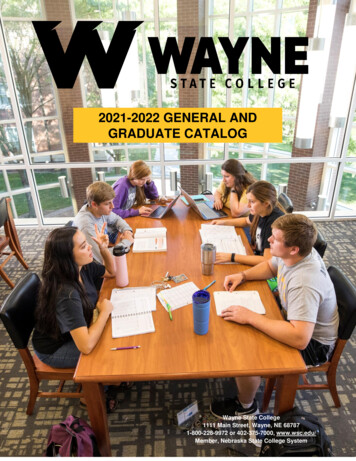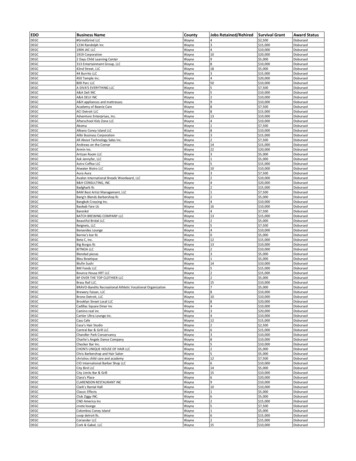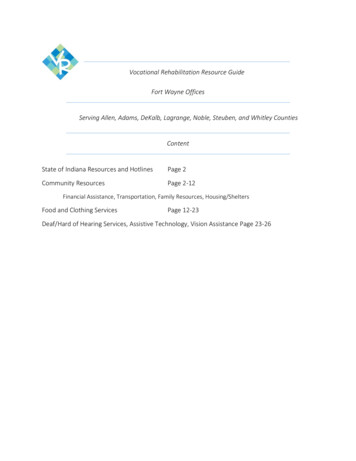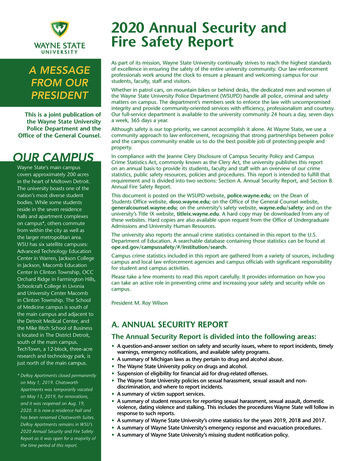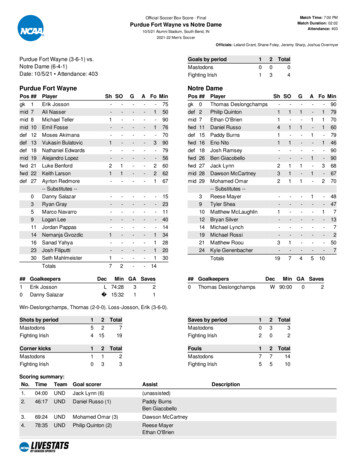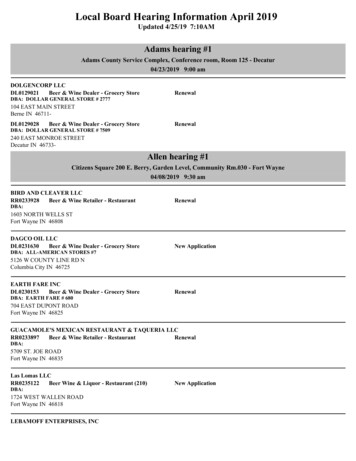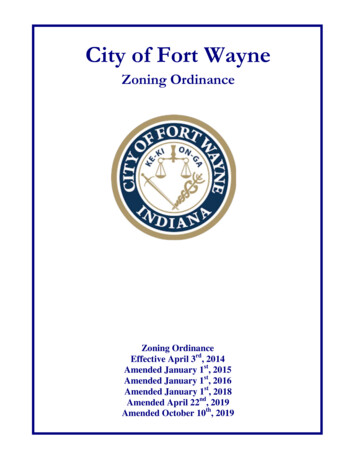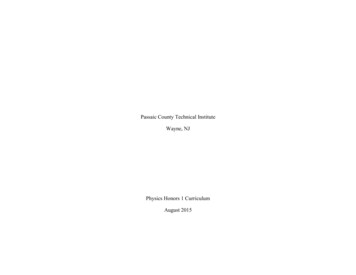
Transcription
Passaic County Technical InstituteWayne, NJPhysics Honors 1 CurriculumAugust 2015
Physics Honors 1 CurriculumAugust 2015I.Course DescriptionPhysics Honors 1 is a college level, algebra based general physics course somewhat similar to a introductory level university physicscourse. It is intended to be a second course taken after a first course in physics or general science. Students taking this course shouldhave also taken and mastered the algebra 2 course. Some trigonometry is required and the necessary topics will be covered in a shortthe math methods review which will be an integral part of this advanced high school physics course.The course covers five general areas in physics. They are Newtonian mechanics, Circular motion and Gravitation, Energy andMomentum, Vibrations and Waves and Introduction to Electricity.This course has been approved for a maximum of four (4) college credits through Seton Hall University’s Project AccelerationProgram. The breakdown is as follows:General Physics IPhysics Lab IPHYS 1701-PPCPHYS 1811- PPC3 Credits1 Credit
II.Course Objectives/OutlineContent Area:Unit Plan1 Title:PhysicsForces and MotionTimeFrameGrade(s)9 Weeks10, 11, 12Learning Objectives Given a graph of position or velocity as a function of time, recognize in what time intervals the position, velocity and acceleration ofan object are positive, negative, or zero and sketch a graph of each quantity as a function of time PS2.A Represent forces in diagrams or mathematically using appropriately labeled vectors with magnitude, direction, and units during theanalysis of a situation. PS2.A Understand and apply the relationship between the net force exerted on an object, its inertial mass, and its acceleration to a variety ofsituations. PS2.A Analyze data to support the claim that Newton’s second law of motion describes the mathematical relationship among the net forceon a macroscopic object, its mass, and its acceleration. HS-PS2-1 Predict the change in momentum of an object from the average force exerted on the object and the interval of time during which theforce is exerted. PS2.A Use mathematical representations to support the claim that the total momentum of a system of objects is conserved when there is nonet force on the system. HS-PS2-2Science and Engineering PracticesDisciplinary Core IdeasCrosscutting ConceptsPS2.A: Forces and Motion (pp. 114Cause and Effect (pp. 87-89, NRC, 2012)Planning and Carrying outInvestigations (pp. 59- 61, NRC,116, NRC, 2012) Empirical evidence is required to differentiate2012) Newton’s second law accuratelybetween cause and correlation and make claims aboutPlanning and carrying out investigations predicts changes in the motion ofspecific causes and effects. (HS-PS2-1)in 9-12 builds on K-8 experiences andmacroscopic objects. (SLO 1, 2 & Systems can be designed to cause a desired effect.progresses to include investigations that 3),(HS-PS2-1)(HS-PS2-3)provide evidence for and test Momentum is defined for a particularconceptual, mathematical, physical, and frame of reference; it is the mass timesSystems and System Models (pp. 91-94, NRC,empirical models.the velocity of the object. (SLO 5),(HS2012) Plan and conduct an investigationPS2-2) When investigating or describing a system, theindividually and collaboratively to If a system interacts with objectsboundaries and initial conditions of the system needproduce data to serve as the basis foroutside itself, the total momentum of the to be defined. (HS-PS2-2)evidence, and in the design: decide onsystem can change; however, any such
types, how much, and accuracy of dataneeded to produce reliablemeasurements and consider limitationson the precision of the data (e.g.,number of trials, cost, risk, time), andrefine the design accordingly. (HS-PS21),(HSPS2-3)change is balanced by changes in themomentum of objects outside the system.(HS-PS2-2),(HS-PS2-3),(SLO 5)ETS1.A: Defining and Delimiting anEngineering Problem (pp. 204-206,NRC, 2012) Criteria and constraints also includeAnalyzing and Interpreting Data (pp. satisfying any requirements set by61-63, NRC, 2012) Analyzing data in 9– society, such as taking issues of risk12 builds on K–8 and progresses tomitigation into account, and they shouldintroducing more detailed statisticalbe quantified to the extent possible andanalysis, the comparison of data sets for stated in such a way that one can tell if aconsistency, and the use of models togiven design meets them. (secondary togenerate and analyze data.HS-PS2-3) ETS1.C: Analyze data using tools,technologies, and/or models (e.g.,Optimizing the Design Solution (pp.computational, mathematical) in order208- 210, NRC, 2012)to make valid and reliable scientific Criteria may need to be broken downclaims or determine an optimal designinto simpler ones that can be approachedsolution. (SLO 1, 2 & 3), (HS-PS2-1)systematically, and decisions about thepriority of certain criteria over othersUsing Mathematics and(trade-offs) may be needed. (HS-PS2-3)Computational Thinking (pp. 64-67,NRC, 2012) Mathematical andcomputational thinking at the 9– 12level builds on K–8 and progresses tousing algebraic thinking and analysis, arange of linear and nonlinear functionsincluding trigonometric functions,exponentials and logarithms, andcomputational tools for statisticalanalysis to analyze, represent, and-----------------------------------Connections to Nature of ScienceScience Models, Laws, Mechanisms, and TheoriesExplain Natural Phenomena (pp. 96-101, AppendixH: NRC, 2013) Theories and laws provide explanations in science.(HS-PS2-1) Laws are statements or descriptions of therelationships among observable phenomena. (HSPS2-1)
model data. Simple computationalsimulations are created and used basedon mathematical models of basicassumptions. Use mathematical representations ofphenomena to describe explanations.(SLO 1, 2 & 4), (HS-PS2-2)Constructing Explanations andDesigning Solutions (pp. 67-71, NRC,2012) Constructing explanations anddesigning solutions in 9–12 builds onK–8 experiences and progresses toexplanations and designs that aresupported by multiple and independentstudent-generated sources of evidenceconsistent with scientific ideas,principles, and theories. Apply scientific ideas to solve adesign problem, taking into accountpossible unanticipated effects. (HS-PS23Common Core Common Core Writing Standards:WHST.11-12.7 WHST.11-12.9 Common Core Reading Standards:RST.11-12.1, RST.11-12.7Content Area:Unit Plan 2 Title:PhysicsTypes of InteractionsLearning ObjectivesTimeFrameGrade(s) 10, 11, 1212 Weeks
Calculate the gravitational force two objects exert on each other in a uniform field. PS2.B 2Use mathematical representations of Newton’s Law of Gravitation to describe and predict the gravitational forces between objects.HS-PS2-4 3 Relate the period, orbital radius and speed of an object in a circular orbit, and use the model speed 2πR/T to predict unknownquantities. Teacher Note: Students connect this concept to Kepler's third law by replacing the mass of the earth with the mass of thesun and let R represent the radius of orbit of the planet being studied. PS2.B, ESS1.B 4 Use mathematical or computational representations to predict the motion of orbiting objects in the solar system. HS-ESS1-4 5 Represent and describe the two types of forces that a surface can exert on an object - a normal force, and a friction force parallel tothe surface and dependent on the normal force and textures of the two surfaces. PS2.A 6 Use Newton’s Second Law along with themathematical relationship among friction force and normal force to predict unknown quantities involving one-dimensional motionwith constant velocity and one-dimensional PS2.A Explain contact forces (tension, friction, normal) as arising from interatomic electric forces and their certain directions. PS1.A 8 Communicate scientific and technical information about why the molecular-level structure is important in the functioning ofdesigned materials.* HS-PS2-6Science and Engineering PracticesDisciplinary Core IdeasCrosscutting ConceptsUsing Mathematics andPS2.A: Forces and MotionPatterns Newton’s second law accurately predicts Different patterns may be observed at each ofComputational ThinkingMathematical and computationalchanges in the motion of macroscopic objects.the scales at which a system is studied and canthinking at the 9– 12 level builds on K– (SLO 1, 2 & 3) PS1.A:provide evidence for causality in explanations8 and progresses to using algebraicof phenomena. (HS-PS2-4)thinking and analysis, a range of linearStructure and Properties of MatterCause and Effectand nonlinear functions including Each atom has a charged substructure Empirical evidence is required to differentiatetrigonometric functions, exponentialsconsisting of a nucleus, which is made ofbetween cause and correlation and makeand logarithms, and computational tools protons and neutrons, surrounded byclaims about specific causes and effects.for statistical analysis to analyze,electrons.(HSPS2-1),(HS-PS2-5)represent, and model data. Simple The structure and interactions of matter atSystems and System Modelscomputational simulations are createdthe bulk scale are determined by electrical When investigating or describing a system,and used based on mathematical models forces within and between atoms. PS2.B:the boundaries and initial conditions of theof basic assumptions.system need to be defined. (HS-PS2-2) Use mathematical representations ofTypes of Interactionsphenomena to describe explanations. Newton’s law of universal gravitation andStructure and Function(HS-PS2- 4) (HS-ESS1-4), (SLO 1, 2, 5Coulomb’s law provide the mathematical Investigating or designing new systems or& 6)models to describe and predict the effects ofstructures requires a detailed examination of
Obtaining, Evaluating, andCommunicating InformationObtaining, evaluating, andcommunicating information in 9–12builds on K–8 and progresses toevaluating the validity and reliability ofthe claims, methods, and designs. Communicate scientific and technicalinformation (e.g. about the process ofdevelopment and the design andperformance of a proposed process orsystem) in multiple formats (includingorally, graphically, textually, andmathematically). (HS-PS2-6)Common Core gravitational and electrostatic forcesbetween distant objects. (HS-PS2-4) Forces at a distance are explained by fields(gravitational, electric, and magnetic)permeating space that can transfer energythrough space. Magnets or electric currentscause magnetic fields; electric charges orchanging magnetic fields cause electricfields. (HS-PS2-4) Attraction and repulsion between electriccharges at the atomic scale explain thestructure, properties, and transformations ofmatter, as well as the contact forces betweenmaterial objects. (HS-PS2-6) ESS1.B:Earth and the Solar System Kepler’s laws describe common features ofthe motions of orbiting objects, includingtheir elliptical paths around the sun. Orbitsmay change due to the gravitational effectsfrom, or collisions with, other objects in thesolar system. (HS-ESS1-4), (SLO 6)the properties of different materials, thestructures of different components, andconnections of components to reveal itsfunction and/or solve a problem. (HS-PS2-6)Scale, Proportion, and Quantity Algebraic thinking is used to examineexponential growth). -------------------Connections to Nature of ScienceModels, Laws, Mechanisms, and TheoriesExplain Natural Phenomena Theories and laws provide explanations inscience. (HS-PS2-1) Laws are statements or descriptions of therelationships among observable phenomena.(HS-PS2-4)Common Core Writing Standards:WHST.11-12.2 WHST.11-12.7 WHST.11-12.8 WHST.11-12.9Common Core Reading Standards:RST.11-12.1, RST.11-12.7Content Area:Unit Plan 3 Title:PhysicsEnergyLearning ObjectivesTimeFrameGrade(s)2 Weeks10, 11, 12
Identify and quantify the various types of energies within a system of objects in a well-defined state, such as elastic potential energy,gravitational potential energy, kinetic energy, and thermal energy and represent how these energies may change over time. PS3.A,PS3.B 2 Calculate changes in kinetic energy and gravitational potential energy of a system using representations of that system. PS3.A 3 Construct an explanation, using atomic-scale interactions and probability, of how a closed system approaches thermal equilibriumwhen after energy is transferred to it or from it in a thermal process. PS3.A 4 Develop and use models to illustrate that energy at the macroscopic scale can be accounted for as a combination of energy associatedwith the motions of particles (objects) and energy associated with the relative positions of particles (objects). HS-PS3-2 5 Create a computational model to calculate the change in the energy of one component in a system when the change in energy of theother component(s) and energy flows in and out of the system are known. HS-PS3-1Science and Engineering PracticesDisciplinary Core IdeasCrosscutting ConceptsDeveloping and Using ModelsPS2.B: Types of InteractionsPatternsModeling in 9–12 builds on K–8 and Newton’s law of universal gravitation and Different patterns may be observed at each of theprogresses to using, synthesizing, andCoulomb’s law provide the mathematicalscales at which a system is studied and can providedeveloping models to predict and showmodels to describe and predict the effectsevidence for causality in explanations ofrelationships among variables betweenof gravitational and electrostatic forcesphenomena. (HS-PS2-4)systems and their components in thebetween distant objects. (HS-PS2-4)natural and designed worlds. Forces at a distance are explained byCause and Effect Develop and use a model based onfields (gravitational, electric, and Empirical evidence is required to differentiateevidence to illustrate the relationshipsmagnetic) permeating space that canbetween cause and correlation and make claimsbetween systems or betweentransfer energy through space. Magnets or about specific causes and effects. (HSPS2-5)components of a system. (SLO 1),electric currents cause magnetic fields; Cause and effect relationships can be suggested(HSPS3-2)electric charges or changing magneticand predicted for complex natural and humanfields cause electric fields. (HS-PS2designed systems by examining what is known4),(HS-PS2-5)about smaller scale mechanisms within the system.Planning and Carrying Out Attraction and repulsion between electric (HS-PS3-5)InvestigationsPlanning and carrying out investigations charges at the atomic scale explain theto answer questions or test solutions tostructure, properties, and transformationsStructure and Functionproblems in 9–12 builds on K–8of matter, as well as the contact forces Investigating or designing new systems orexperiences and progresses to includebetween material objects. (HS-PS2-6)structures requires a detailed examination of theinvestigations that provide evidence for PS3.A:properties of different materials, the structures ofand test conceptual, mathematical,different components, and connections ofphysical, and empirical models.components to reveal its function and/or solve aDefinitions of Energy
Plan and conduct an investigationindividually and collaboratively toproduce data to serve as the basis forevidence, and in the design: decide ontypes, how much, and accuracy of dataneeded to produce reliablemeasurements and consider limitationson the precision of the data (e.g.,number of trials, cost, risk, time), andrefine the design accordingly. (HS-PS33)Using Mathematics andComputational ThinkingMathematical and computationalthinking at the 9– 12 level builds on K–8 and progresses to using algebraicthinking and analysis, a range of linearand nonlinear functions includingtrigonometric functions, exponentialsand logarithms, and computational toolsfor statistical analysis to analyze,represent, and model data. Simplecomputational simulations are createdand used based on mathematical modelsof basic assumptions. Create a computational model orsimulation of a phenomenon, designeddevice, process, or system. (SLO 1 & 2)(HS-PS3-1), (HS-PS3-2)Constructing Explanations andDesigning Solutions “Electrical energy” may mean energystored in a battery or energy transmitted byelectric currents. (secondary to HS-PS2-5)PS3.C: Relationship Between Energy andForces When two objects interacting through afield change relative position, the energystored in the field is changed. (HS-PS3-5)problem. ---------------------Connections to Nature of ScienceScience Models, Laws, Mechanisms, andTheories Explain Natural Phenomena Theories and laws provide explanations inscience. (HS-PS2-4) Laws are statements ordescriptions of the relationships among observablephenomena. (HS-PS2-4)
Constructing explanations and designingsolutions in 9–12 builds on K–8experiences and progresses toexplanations and designs that aresupported by multiple and independentstudent-generated sources of evidenceconsistent with scientific ideas,principles, and theories. Design, evaluate, and/or refine asolution to a complex real-worldproblem, based on scientific knowledge,student-generated sources of evidence,prioritized criteria, and tradeoffconsiderations. (HS-PS3-3)Common Core Common Core Writing Standards:WHST.11-12.7, WHST.9-12.9 Common Core Reading Standards:RST.11-12.1, RST.11-12.7Content Area:Unit Plan 4 Title:PhysicsElectricity and MagnetismTimeFrameGrade(s)7 Weeks10, 11, 12Learning Objectives Develop and use a model of two objects interacting through electric or magnetic fields to illustrate the forces between objects and thechanges in energy of the objects due to the interaction. HS-PS3-5 2 Use mathematical representations of Coulomb’s Law to describe and predict the electrostatic forces between objects. HS-PS2-4 3 Make predictions about the sign and relative quantity of net charge of objects or systems after various charging processes. PS2.B 4 Construct an explanation of a model of electric charge, and make a qualitative prediction about the distribution of positive andnegative electric charges within neutral systems as they undergo various processes. PS2.B 5 Plan and conduct an investigation to provide evidence that an electric current can produce a magnetic field and that a changingmagnetic field can produce an electric current. HS-PS2-5 6
Communicate scientific and technical information about why the molecular-level structure is important in the functioning ofdesigned materials. HS-PS2-5 Design, build, and refine a device that works within given constraints to convert one form of energy into another form of energy HSPS2-6Science and Engineering PracticesDisciplinary Core IdeasCrosscutting ConceptsPlanning and Carrying OutPS2.B: Types of InteractionsPatterns Newton’s law of universal gravitation Different patterns may be observed at each of theInvestigationsPlanning and carrying outand Coulomb’s law provide thescales at which a system is studied and can provideinvestigations to answer questions ormathematical models to describe andevidence for causality in explanations of phenomena.test solutions to problems in 9–12predict the effects of gravitational and(HS-PS2-4)builds on K–8 experiences andelectrostatic forces between distantprogresses to include investigationsobjects. (HS-PS2-4)Cause and Effectthat provide evidence for and test Forces at a distance are explained by Empirical evidence is required to differentiate betweenconceptual, mathematical, physicalfields (gravitational, electric, andcause and correlation and make claims about specificand empirical models.magnetic) permeating space that cancauses and effects. (HSPS2-5) Plan and conduct an investigationtransfer energy through space. Magnets Cause and effect relationships can be suggested andindividually and collaboratively toor electric currents cause magneticpredicted for complex natural and human designedproduce data to serve as the basis forfields; electric charges or changingsystems by examining what is known about smallerevidence, and in the design: decide on magnetic fields cause electric fields.scale mechanisms within the system. (HS-PS3-5)types, how much, and accuracy of data (HS-PS2-4),(HS-PS2-5)needed to produce reliable Attraction and repulsion betweenStructure and Functionmeasurements and consider limitations electric charges at the atomic scale Investigating or designing new systems or structureson the precision of the data (e.g.,explain the structure, properties, andrequires a detailed examination of the properties ofnumber of trials, cost, risk, time), and transformations of matter, as well as the different materials, the structures of differentrefine the design accordingly. (HScontact forces between material objects. components, and connections of components to revealPS2-5)(HS-PS2-6) PS3.Aits function and/or solve a problem. (HS-PS2-6) Using Mathematics andComputational ThinkingMathematical and computationalthinking at the 9– 12 level builds onK–8 and progresses to using algebraicthinking and analysis, a range of linearDefinitions of Energy “Electrical energy” may mean energystored in a battery or energy transmittedby electric currents. (secondary to HSPS2-5) PS3.C:
and nonlinear functions includingtrigonometric functions, exponentialsand logarithms, and computationaltools for statistical analysis to analyze,represent, and model data. Simplecomputational simulations are createdand used based on mathematicalmodels of basic assumptions. Use mathematical representations ofphenomena to describe explanations.(HS-PS2- 4)Obtaining, Evaluating, andCommunicating InformationObtaining, evaluating, andcommunicating information in 9–12builds on K–8 and progresses toevaluating the validity and reliabilityof the claims, methods, and designs. Communicate scientific andtechnical information (e.g. about theprocess of development and the designand performance of a proposedprocess or system) in multiple formats(including orally, graphically,textually, and mathematically). (HSPS2-6)Developing and Using ModelsModeling in 9–12 builds on K–8 andprogresses to using, synthesizing, anddeveloping models to predict andshow relationships among variablesRelationship Between Energy andForces When two objects interacting througha field change relative position, theenergy stored in the field is changed.(HS-PS3-5)
between systems and theircomponents in the natural anddesigned worlds. Develop and use a model based onevidence to illustrate the relationshipsbetween systems or betweencomponents of a system. (HS-PS3-5)Common Core Common Core Writing Standards:WHST.9-12.9, WHST.11-12.2, WHST.11-12.7, WHST.11-12.8, WHST.9-10.10 Common Core Reading Standards:RST.11-12.1Content Area:Unit Plan 5 Title:PhysicsWaves and their ApplicationsTimeFrameGrade(s)5Weeks10, 11, 12Learning Objectives Use mathematical representations to support a claim regarding relationships among the frequency, wavelength, and speed of wavestraveling in various media. HS-PS4-1 2 Evaluate the validity and reliability of claims in published materials of the effects that different frequencies of electromagneticradiation have when absorbed by matter. HS-PS4-4 3 Distinguish between models of radiant energy, and use the scale of the problem to determine at what regimes a particle or wavemodel is more appropriate. PS4.B 4 Evaluate the claims, evidence, and reasoning behind the idea that electromagnetic radiation can be described either by a wave modelor a particle model, and that for some situations one model is more useful than the other. HS-PS4-3 5 Communicate technical information about how some technological devices use the principles of wave behavior and waveinteractions with matter to transmit and capture information and energy HS-PS4-5 Evaluate questions about the advantages of using a digital transmission and storage of information. HS-PS4-2Science and Engineering PracticesDisciplinary Core IdeasCrosscutting ConceptsAsking Questions and DefiningProblemsPS3.D: Energy in Chemical Processes Solar cells are human-made devices thatCause and Effect Empirical evidence is required to differentiate
Asking questions and definingproblems in grades 9–12 builds fromgrades K–8 experiences and progressesto formulating, refining, and evaluatingempirically testable questions anddesign problems using models andsimulations. Evaluate questions that challenge thepremise(s) of an argument, theinterpretation of a data set, or thesuitability of a design. (HSPS4-2)Using Mathematics andComputational ThinkingMathematical and computationalthinking at the 9- 12 level builds on K8 and progresses to using algebraicthinking and analysis, a range of linearand nonlinear functions includingtrigonometric functions, exponentialsand logarithms, and computationaltools for statistical analysis to analyze,represent, and model data. Simplecomputational simulations are createdand used based on mathematicalmodels of basic assumptions. Use mathematical representations ofphenomena or design solutions todescribe and/or support claims and/orexplanations. (HS-PS4-1)Engaging in Argument fromlikewise capture the sun’s energy and produceelectrical energy. (secondary to HS-PS4-5)PS4.A: Wave Properties The wavelength and frequency of a wave arerelated to one another by the speed of travel ofthe wave, which depends on the type of waveand the medium through which it is passing.(HS-PS4-1) Information can be digitized (e.g., a picturestored as the values of an array of pixels); inthis form, it can be stored reliably in computermemory and sent over long distances as aseries of wave pulses. (HS-PS4-2),(HS-PS4-5) [From the 3–5 grade band endpoints] Wavescan add or cancel one another as they cross,depending on their relative phase (i.e., relativeposition of peaks and troughs of the waves),but they emerge unaffected by each other.(Boundary: The discussion at this grade levelis qualitative only; it can be based on the factthat two different sounds can pass a location indifferent directions without getting mixed up.)(HS-PS4-3) PS4.B:Electromagnetic Radiation Electromagnetic radiation (e.g., radio,microwaves, light) can be modeled as a waveof changing electric and magnetic fields or asparticles called photons. The wave model isuseful for explaining many features of electromagnetic radiation, andthe particle model explains other features. (HS-between cause and correlation and make claimsabout specific causes and effects. (HSPS4-1) Cause and effect relationships can besuggested and predicted for complex natural andhuman designed systems by examining what isknown about smaller scale mechanisms withinthe system. (HS-PS4-4) Systems can be designed to cause a desiredeffect. (HS-PS4-5) Systems and System Models Models (e.g., physical, mathematical, computermodels) can be used to simulate systems andinteractions—including energy, matter, andinformation flows—within and between systemsat different scales. (HS-PS4-3)Stability and Change Systems can be designed for greater or lesserstability. (HS-PS4-2) Energy and Matter Energy cannot be created or destroyed–onlymoved between one place and another place,between objects and/or fields, or betweensystems. ions to Engineering, Technology, andApplications of ScienceInterdependence of Science, Engineering, andTechnology Science and engineering complement eachother in the cycle known as research anddevelopment (R&D). (HS-PS4-5)
EvidenceEngaging in argument from evidencein 9–12 builds on K–8 experiences andprogresses to using appropriate andsufficient evidence and scientificreasoning to defend and critique claimsand explanations about natural anddesigned worlds. Arguments may alsocome from current scientific orhistorical episodes in science. Evaluate the claims, evidence, andreasoning behind currently acceptedexplanations or solutions to determinethe merits of arguments. (HS-PS4-3)Obtaining, Evaluating, andCommunicating InformationObtaining, evaluating, andcommunicating information in 9–12builds on K–8 and progresses toevaluating the validity and reliability ofthe claims, methods, and designs. Evaluate the validity and reliabilityof multiple claims that appear inscientific and technical texts or mediareports, verifying the data whenpossible. (HS-PS4-4) Communicate technical informationor ideas (e.g. about phenomena and/orthe process of development and thedesign and performance of a proposedprocess or system) in multiple formats(including orally, graphically, textually,PS4-3) When light or longer wavelengthelectromagnetic radiation is absorbed inmatter, it is generally converted into thermalenergy (heat). Shorter wavelengthelectromagnetic radiation (ultraviolet, X-rays,gamma rays) can ionize atoms and causedamage to living cells. (HS-PS4-4) Photoelectric materials emit electrons whenthey absorb light of a high-enough frequency.(HS-PS4-5) PS4.C:Influence of Engineering, Technology, andScience on Society and the Natural World Modern civilization depends on majortechnological systems. (HS-PS4-2),(HS-PS4-5) Engineers continuously modify thesetechnological systems by applying scientificknowledge and engineering design practices toincrease benefits while decreasing costs andrisks. (HS-PS4-2)Information Technologies andInstrumentation Multiple technologies based on theunderstanding of waves and their interactionswith matter are part of everyday experiences inthe modern world (e.g., medical imaging,communications, scanners) and in scientificresearch. They are essential tools forproducing, transmitting, and capturing signalsand for storing and interpreting the informationcontained in them. (HS-PS4-5)Connections to Engineering, Technology, andApplications of ScienceESS1.A: The Universe and Its Stars The study of stars’ l
Passaic County Technical Institute . Wayne, NJ . Physics Honors 1 Curriculum . August 2015 . Physics Honors 1. Curriculum. August 2015. I. Course Description . Physics Honors 1 is a college level, algebra based general physics course somewhat similar to a introductory level university physics

